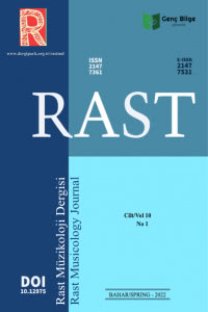Meslek yüksek okulu öğrencilerinin ruhsal durum algıları ile müzik tercihlerinin incelenmesi
SCL-90R, Müzik Tercihi, Üniversite Öğrencileri, Ruhsal Durum, Müzik Dinleme Tercihleri
Examination of the vocational high school students’ perceptions of psychological status and music preference
SCL-90R, Music Preference, University Students, Psychology of Music, Music Listening Preferences,
___
- 1. Hargreaves DJ, North AC. The Social Psychology of Music. New York: Oxford University Press; 2009.
- 2. North AC, Hargreaves DJ, Hargreaves JJ. Uses of Music in Everyday Life. Music Percept. 01 Eylül 2004;22(1):41-77.
- 3. Rentfrow PJ. The Role of Music in Everyday Life: Current Directions in the Social Psychology of Music. Soc Personal Psychol Compass. 01 Mayıs 2012;6(5):402-16.
- 4. Greb F, Schlotz W, Steffens J. Personal and situational influences on the functions of music listening: Psychol Music [Internet]. 24 Ağustos 2017 [a.yer 20 Aralık 2021]; Erişim adresi: https://journals.sagepub.com/doi/10.1177/0305735617724883
- 5. Kuntsche E, Mével LL, Berson I. Development of the four-dimensional Motives for Listening to Music Questionnaire (MLMQ) and associations with health and social issues among adolescents: Psychol Music [Internet]. 12 Ocak 2015 [a.yer 20 Aralık 2021]; Erişim adresi: https://journals.sagepub.com/doi/10.1177/0305735614562635
- 6. North AC, Hargreaves DJ, O’Neill SA. The importance of music to adolescents. Br J Educ Psychol. Haziran 2000;70:255-72.
- 7. DSÖ. Dünya Sağlık Örgütü [Internet]. 2021 [a.yer 21 Aralık 2021]. Erişim adresi: https://www.who.int
- 8. Şenel O. Müzik tercihinin karmaşık arka planı. Uluslararası Sosyal Araştırmalar Dergisi. 2014;7(30):213-27.
- 9. Rentfrow PJ, McDanald JA, Oldmeadow JA. You are what you listen to: Young people’s stereotypes about music fans. - PsycNET [Internet]. APA PsycNET. 2009 [a.yer 19 Aralık 2021]. Erişim adresi: https://psycnet.apa.org/record/2009-07622-004
- 10. Rentfrow PJ, Gosling SD. The do re mi’s of everyday life: The structure and personality correlates of music preferences. J Pers Soc Psychol. 2003;84(6):1236-56.
- 11. Baker F, Bor W. Can music preference indicate mental health status in young people? Australas Psychiatry Bull R Aust N Z Coll Psychiatr. 2008;16(4):284-8.
- 12. Şenel O. Müzik Tercihi Ve Sosyal Kimlik İlişkisi - The Relatıonshıp Between Musıc Preference And Socıal Identıty. 2014;
- 13. Erdal B. Müzik Tercihi ve Kişilik İlişkisi. Cumhuriyet Üniversitesi Edebiyat Fakültesi Sosyal Bilimler Dergisi. 2010;33(2):188-96.
- 14. Rentfrow PJ, Mcdonald JA. Preference, Personality, and Emotion [Internet]. Handbook of Music and Emotion: Theory, Research, Applications. Oxford University Press; 2009 [a.yer 19 Aralık 2021]. Erişim adresi: https://oxford.universitypressscholarship.com/view/10.1093/acprof:oso/9780199230143.001.0001/acprof-9780199230143-chapter-24
- 15. Konečni V. 17 – Social Interaction and Musical Preference. undefined [Internet]. 1982 [a.yer 19 Aralık 2021]; Erişim adresi: https://www.semanticscholar.org/paper/17-%E2%80%93-Social-Interaction-and-Musical-Preference-Kone%C4%8Dni/800d7d5ed7f1305181e13e3d632c482e60fc9221
- 16. Sezer F. The effects of music on anger and psychological symptoms. J Hum Sci. 19 Nisan 2011;8(1):1472-93.
- 17. Güner N. Ergenlerin Dinledikleri Müzik Türü İle Saldırganlık Düzeyleri Arasındaki İlişkinin İncelenmesi. İçinde: Ergenlerin Dinledikleri Müzik Türü İle Saldırganlık Düzeyleri Arasındaki İlişkinin İncelenmesi [İnternet]. Konya; 1998 [a.yer 19 Aralık 2021]. s. 291-9. Erişim adresi: https://tez.yok.gov.tr/UlusalTezMerkezi/tezDetay.jsp?id=2bbAzIpTCYFUd_gu1cU9UQ&no=2bbAzIpTCYFUd_gu1cU9UQ
- 18. Yağışan N. Musical Preferences of University Students and the Correlation Of These Preferences with Aggressiveness. SED J Art Educ [İnternet]. 13 Kasım 2013 [a.yer 19 Aralık 2021];1(2). Erişim adresi: http://dergipark.gov.tr/doi/10.7816/sed-01-02-07
- 19. Juslin PN, Liljeström S, Västfjäll D, Barradas G, Silva A. An experience sampling study of emotional reactions to music: Listener, music, and situation. Emotion. 2008;8(5):668-83.
- 20. Sittler MC, Worschech F, Wilz G, Fellgiebel A, Wuttke-Linnemann A. Psychobiological mechanisms underlying the health-beneficial effects of music in people living with dementia: A systematic review of the literature. Physiol Behav. 01 Mayıs 2021;233:113338.
- 21. Soysal F. Listening To Foreign (Popular)1 Music: Research On The Music Preferences Of 11-13 Age Group Children in Turkey. RHESL. 2012;5(16):79-90.
- 22. Barsky AJ, Peekna HM, Borus JF. Somatic symptom reporting in women and men. J Gen Intern Med. 01 Nisan 2001;16(4):266-75.
- 23. Lei X, Liu C, Jiang H. Mental health of college students and associated factors in Hubei of China. PLOS ONE. 02 Temmuz 2021;16(7):e0254183.
- 24. Zhang J, Zhang X. Chinese college students’ SCL-90 scores and their relations to the college performance. Asian J Psychiatry. 01 Nisan 2013;6(2):134-40.
- 25. Auerbach RP, Mortier P, Bruffaerts R. WHO World Mental Health Surveys International College Student Project: Prevalence and distribution of mental disorders. - PsycNET. Journal of Abnormal Psychology [Internet]. 2018 [a.yer 21 Aralık 2021];127(7). Erişim adresi: https://psycnet.apa.org/doiLanding?doi=10.1037%2Fabn0000362
- 26. Alonso J, Mortier P, Auerbach RP, Bruffaerts R, Vilagut G, Cuijpers P, vd. Severe role impairment associated with mental disorders: Results of the WHO World Mental Health Surveys International College Student Project. Depress Anxiety. 01 Eylül 2018;35(9):802-14.
- 27. Auerbach RP, Alonso J, Axinn WG, Cuijpers P, Ebert DD, Green JG, vd. Mental disorders among college students in the World Health Organization World Mental Health Surveys. Psychol Med. Ekim 2016;46(14):2955-70.
- 28. Bruffaerts R, Mortier P, Kiekens G, Auerbach RP, Cuijpers P, Demyttenaere K, vd. Mental health problems in college freshmen: Prevalence and academic functioning. J Affect Disord. 01 Ocak 2018;225:97-103.
- 29. Shang Y. An Evaluation System For The Influence Of Modern Pop Music Teaching On Students’ Psychology in New Media Environment. Rev Argentİna Clin Psicol. 2020;29(1):1064-9.
- 30. Sezer F. Öfke ve psikolojik belirtiler üzerine müziğin etkisi. 2011;22.
- ISSN: 2147-7361
- Yayın Aralığı: Yılda 4 Sayı
- Başlangıç: 2013
- Yayıncı: Genç Bilge Yayıncılık (Young Wise)
Çocuğun sosyalleşme süreci olarak yaratıcı sanatsal ve müzikal etkinliği
Irina Vladimirovna WAGNER, Ekaterina Mikhailovna AKİSHİNA, Elena Petrovna OLESİNA
V.R.'nin “Game” şarkısının taslak versiyonlarında özne-nesne ilişkileri kavramı. Tsoy
V.R.'nin “Game” şarkısının taslak versiyonlarında özne-nesne ilişkileri kavramı. Tsoy
The Effect of Playing Instrument on Voice Training
Meslek yüksek okulu öğrencilerinin ruhsal durum algıları ile müzik tercihlerinin incelenmesi
Gonca SOYSAL, N. Fikri SOYSAL, Elçin BALCI
Preludes and fugues for piano in the polyphonic works of Chinese composers
Marianna CHERNYAVSKA, Mengzhe ZHANG
Vokalist mi yoksa oyuncu mu: Müzikal tiyatro türünde hangisi daha iyi performans göstermeye hazır?
Marina KRUGLOVA, Anna SHCHERBAKOVA, Aigul GAREEVA, Alexander VASİLENKO
Balina Şarkısı: Kambur Balina Megaptera Novaeangliae Kültürlerinde Müzikal Pratikler
